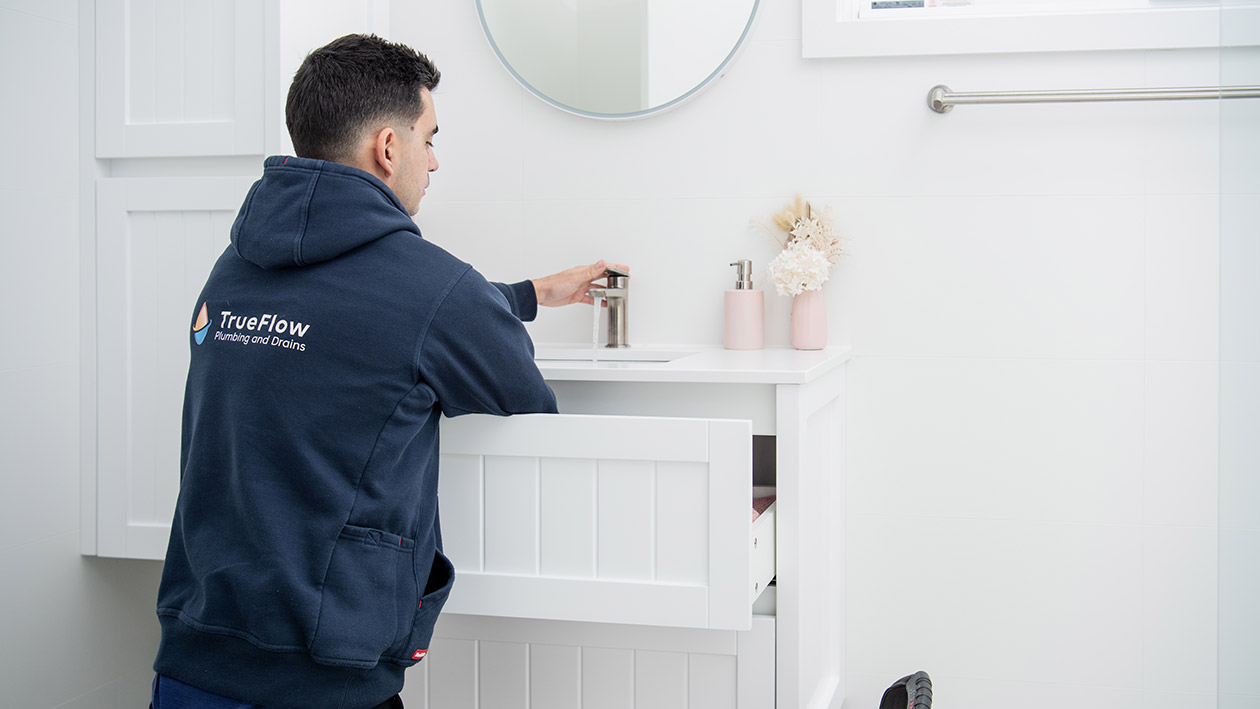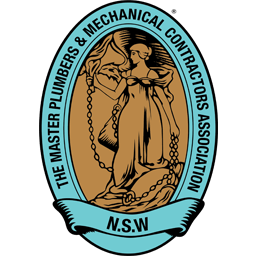Is a clogged drain slowing you down? Have you ever stood in ankle-deep shower water because of a clog? That’s not a relaxing way to start your day! This guide will help you get your plumbing flowing smoothly again by offering clear troubleshooting steps and easy-to-follow DIY solutions.
Troubleshooting Guide: Pinpoint Your Problem
Before you start fixing, figure out what’s causing the trouble. This will save you time and effort!
Where’s the Clog?
- Bathroom Sink: Usually hair, toothpaste gunk, soap, fats, or things dropped accidentally.
- Shower/Bathtub: Mostly hair, soap buildup, sometimes even bath product clumps.
- Toilet: Too much toilet paper, wet wipes (even “flushable” ones), personal items, or accidentally flushed toys.
What’s Causing the Blockage?
- Grease: Feels slimy and thick. Hot water might make it flow for a bit, but it’ll clog again. Avoid pouring grease or cooking oil down the sink!
- Hair: Creates tangled messes that catch other stuff. Look for dark, stringy clumps, this is particularly the case in the Shower.
- Solid Objects: Toys, hygiene items, jewellery – anything dropped down the drain can cause a total blockage.
- Tree Roots: If you suspect this, you’ll probably have slow drains often and might hear gurgling noises. Expert Tip: If you believe a Council-owned tree is causing the blockage, have your plumber submit a written report with evidence to the Council for investigation. Councils are not obligated to clear private service lines, arrange CCTV inspections, dig up or replace private lines, or install inspection openings.
- Wet wipes: Many people assume wet wipes are safe to flush down the toilet, but they are a common cause of drain blockages.
How Severe is the Clog?
- Slow Drainage: Might be a clog you can fix yourself.
- Standing Water: Indicates a tougher clog. Be careful trying DIY fixes, and if they don’t work, consider a plumber.
- Multiple Drains Affected: Means a possible problem in your main sewer line – definitely call a professional.
- Sewage Backup: This is both gross and a health risk. Call a plumber immediately!
Need Help Fast? Don’t hesitate to call a plumber for expert help for emergencies or if figuring it out feels overwhelming.
DIY Solutions: Start Simple, Then Get Tougher
Basic Fixes
Boiling Water
- Boil a full kettle of water.
- Carefully pour directly down the drain in a slow, steady stream. Safety Tip: Wear gloves to avoid splashes.
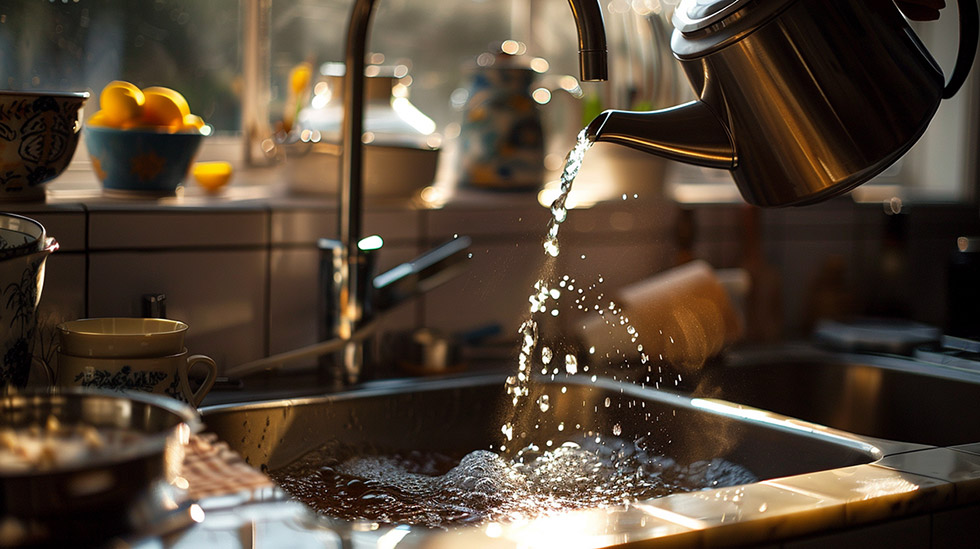
Baking Soda & Vinegar
- Sprinkle ½ cup of baking soda down the drain.
- Pour ½ cup of white vinegar after it.
- Cover the drain for 15 minutes.
- Flush with hot water. Safety Tip: Stand back when adding vinegar, as the fizz can rise up
Plunger
- Fill the basin/tub with enough water to cover the plunger’s cup.
- Create a tight seal over the drain.
- Push and pull the plunger vigorously for about 30 seconds.
Chemical Drain Cleaners
- Choose an enzyme-based cleaner for less pipe damage risk.
- Follow the product instructions precisely regarding amounts and wait times.
- Flush thoroughly with water after use. Safety Tip: Wear gloves, goggles, and ventilate the area well.
Advanced Fixes
Coat Hanger Snake
- Straighten a wire hanger, leaving a small hook at one end.
- Gently feed it down the drain, twisting as you go.
- Hook the clog and carefully pull it out. Safety Tip: Wear gloves to avoid sharp edges
Plumber’s Snake (Drain Auger)
- Feed the drain auger’s cable down the drain.
- Rotate the handle to break up the clog.
- Slowly retract the auger to pull out the debris. Safety Tip: Instructions vary by auger type, so consult the manual.
Important: For recurring clogs or uncertain situations, a plumber protects your pipes and saves you frustration in the long run.
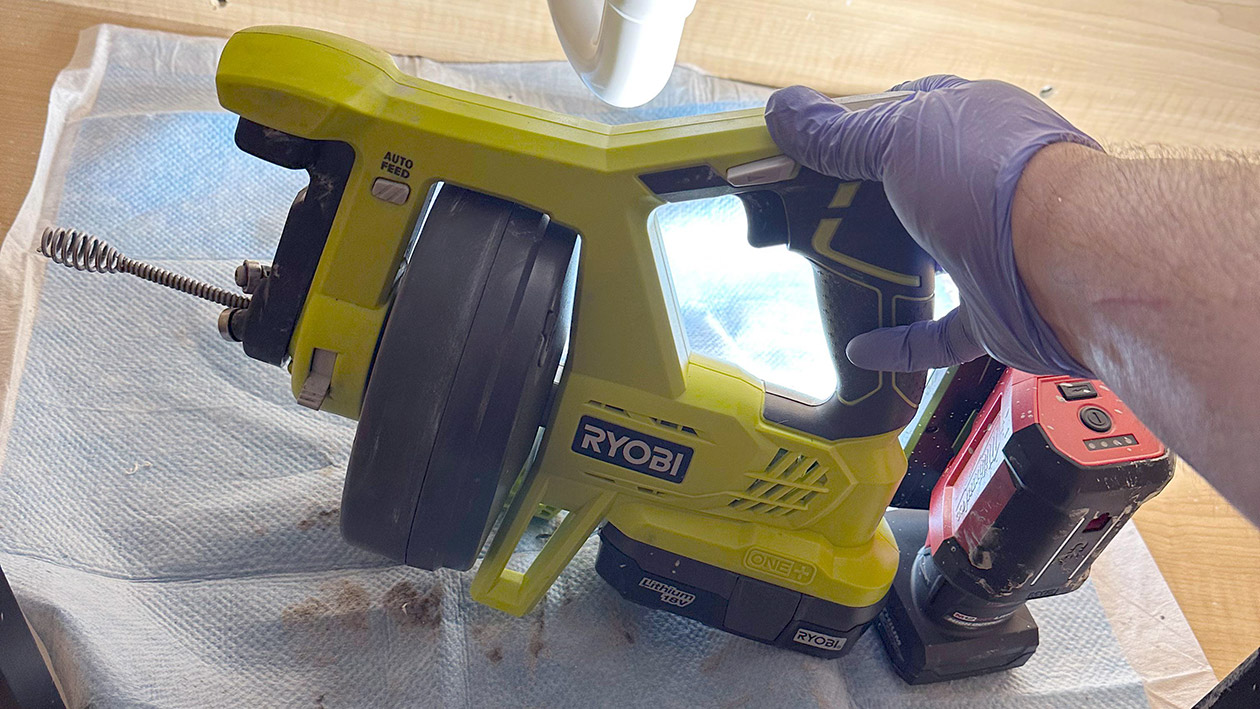
When to Call a Plumber
While DIY methods are great for many drain issues, sometimes calling a plumber who specialises in blocked drains is the wisest move. Here is a checklist of scenarios where attempting DIY drain clearing could be problematic:
- Multiple Drains Clogged: This often means the problem lies in your main sewer line, which requires specialized tools and expertise.
- Recurring Clogs: If a drain keeps clogging up despite your efforts, there might be a deeper issue like damaged pipes, tree root intrusion, or incorrect plumbing installation.
- Sewage Backup: Not only unpleasant but a potential health hazard. A plumber can fix this safely and effectively.
- Old or Fragile Pipes: Harsh chemicals or overly forceful methods (like some snaking techniques) could damage old or weakened pipes.
- You Don’t Have the Right Tools: Drain cameras and professional-grade snakes make a huge difference for tough clogs. A plumber has these.
- Unsure or Uncomfortable: It’s okay to admit plumbing isn’t your thing! A plumber provides peace of mind and can often save you money by fixing it properly the first time.
Remember: Sometimes, the fastest and most cost-effective solution is to bring in a professional from the start.
Preventative Measures: Keep Your Drains Flowing Smoothly
A little prevention goes a long way! Follow these tips to avoid future clogs:
- Drain Strainers: Inexpensive mesh strainers in sinks and bathtubs catch hair, food particles, and other debris before they go down the drain.
- No Grease Down the Sink: Once cooking grease has cooled and solidified, pour it into a container and dispose of it in the trash.
- Regular Hot Water Flushes: Once a week, pour a kettle of hot water down your kitchen sink and bathtub to help dissolve grease and soap buildup.
- Mindful Disposal: Toilet paper is the ONLY item designed to be flushed. Trash the rest (wipes, feminine products, etc.).
- Occasional Enzyme Cleaner: These are gentler than harsh chemicals and help maintain healthy drains.
- Use solvent-welded joints: Some Councils within New South Wales recommend upgrading private service lines to PVC with solvent-welded joints to prevent blockages
Dylan Attard, a licensed plumber from True Flow Plumbing and Drains, provides this expert tip, “Hair catchers in your drains and regular hot water flushes save you tons of future headaches. And remember, your garbage can is a better friend to grease and wipes than your drain!”
Maintenance of your pipes is always an excellent way to prevent costly blockages. Property owners should adhere to relevant Australian Standards and the Plumbing Code of Australia when maintaining their service lines.
By adding these simple steps to your routine, you’ll save yourself the hassle (and potential costs) of future drain disasters!
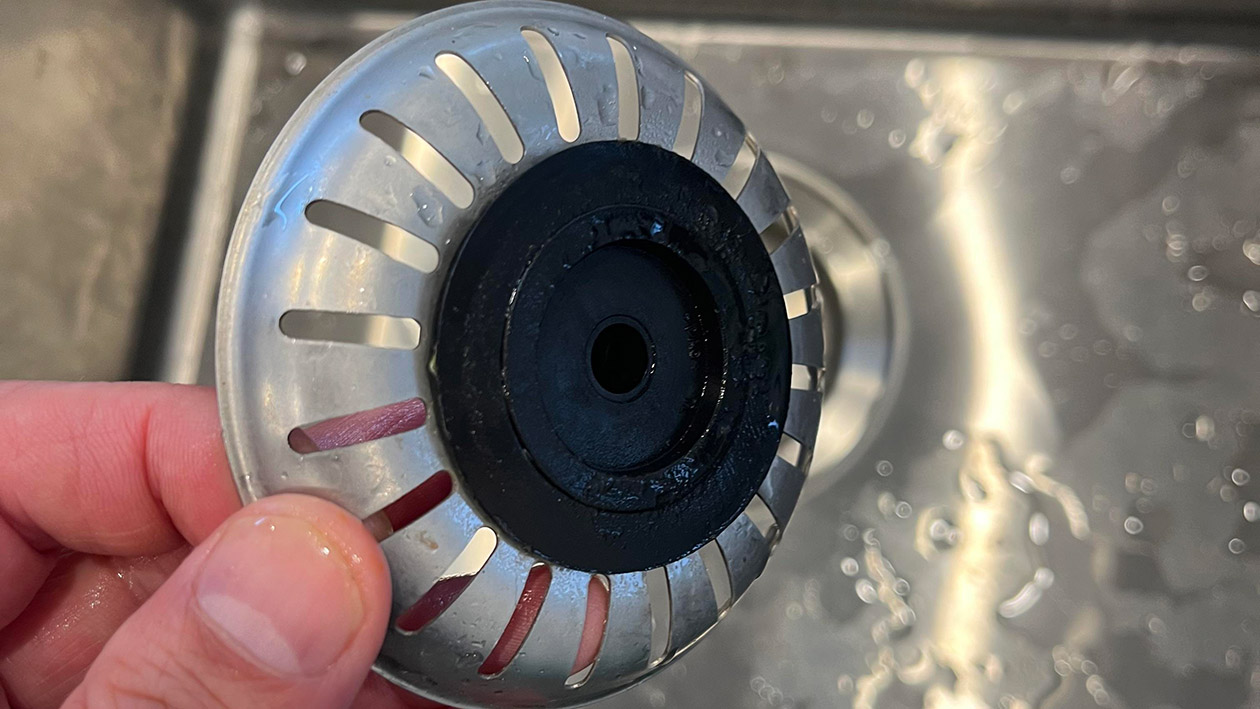
Environmental Impact of Drain Cleaning Methods
When tackling a blocked drain, your chosen method affects the immediate problem and the world around us. It’s crucial to consider eco-friendliness when selecting your approach to drain maintenance. Here, we’ll discuss the environmental ramifications of various drain-clearing methods, focusing on home remedies versus chemical cleaners, and underline the importance of environmentally safe practices.
Home remedies for drain cleaning often utilize components like baking soda, vinegar, or boiling water. These substances are naturally occurring or benign, making them preferable for those concerned about environmental impact. Contrastingly, chemical cleaners contain harsh substances that can damage aquatic ecosystems, contaminate water sources, and pose risks to wildlife and plant life when they inevitably enter the sewer system and are released into the environment.
The Importance of Environmentally Safe Practices for Drain Maintenance
Emphasizing environmentally safe practices plays a substantial role in maintaining a healthy ecosystem. For instance, employing a plunger or a drain snake aids in dislodging blockages mechanically rather than chemically, reducing the likelihood of introducing toxic chemicals into the sewage system. Committing to environmentally friendly methods helps preserve biodiversity, ensures cleaner waterways, and aligns with sustainable living initiatives. Whenever possible, opt for physical tools or eco-friendly solutions to keep your drains flowing freely while protecting our planet.
- Mechanical Methods: Plungers and drain snakes offer a direct approach without chemicals.
- Natural Cleaners: Baking soda, vinegar, and hot water can be surprisingly effective with less environmental risk.
Costs of Drain Clearing Services: What to Expect
When it comes to unblocking a drain, understanding the potential costs involved is crucial for deciding whether to work on your own or call in the pros.
DIY drain clearing can seem cost-effective initially, but it’s important to consider the price of materials and tools you may need to purchase. These can range from simple plungers to sophisticated plumbing snakes or chemical cleaners. In contrast, professional services may seem pricier, but they offer comprehensive solutions that can prevent recurring issues—and thus, future costs. Remember, a botched DIY job could lead to even more expensive repairs.
Understanding Professional Pricing Structures
Professional drain cleaning services typically have a standard call-out fee, followed by variable pricing depending on the severity and location of the blockage. Some common pricing structures include:
- Flat rate: A single fee for the entire service.
- Hourly rate: Fees based on the time taken to clear the drain.
- Additional charges: For extra services such as camera inspections or emergency after-hours work.
It’s essential to ask for a detailed quote before work begins to avoid unexpected charges.
Tips for Saving Money on Quality Drain Clearing Services
Despite the necessity of professional intervention, there are ways to reduce the financial burden without compromising quality:
- Regularly maintain your drains to prevent severe blockages and the need for costly repairs.
- Look out for service specials or discounts offered by local plumbing businesses.
- Do not ignore the early signs of a blocked drain—addressing issues promptly can save you money in the long run.
By staying informed and proactive, you can navigate the costs of drain clearing services effectively and ensure your plumbing system remains in top condition.
Frequently Asked Questions
What is the best homemade drain cleaner?
The best homemade drain cleaner depends on what’s causing your clog. Baking soda and vinegar is a basic, all-around option for mild grease or soap clogs. For stubborn grease, try hot water and dish soap. Boiling water alone can also dissolve minor grease buildup. However, none of these homemade solutions are a magic bullet for serious blockages caused by hair or solid objects. If the clog is severe, calling a plumber is often the safer and more effective solution in the long run.
Will coke unclog drains?
Coke can sometimes help clear minor drain clogs, but it’s not a miracle solution. Here’s why:
- Phosphoric Acid: Coke contains phosphoric acid, which can break down some types of grime and build up, contributing to clogs. It’s particularly helpful against grease or soap-related gunk.
- Limitations: Coke won’t dissolve hair, solid objects, or severe blockages. It’s also not as effective as commercial drain cleaners designed for the task.
- Environmental Concerns: Pouring sugary soft drinks down the drain isn’t the most eco-friendly solution.
If you want to try Coke, use room-temperature soda for better results and let it sit in the drain for at least an hour. However, DIY methods like baking soda and vinegar, or a drain snake are likely more effective for tough clogs. A plumber is your best bet for stubborn clogs or recurring problems.
